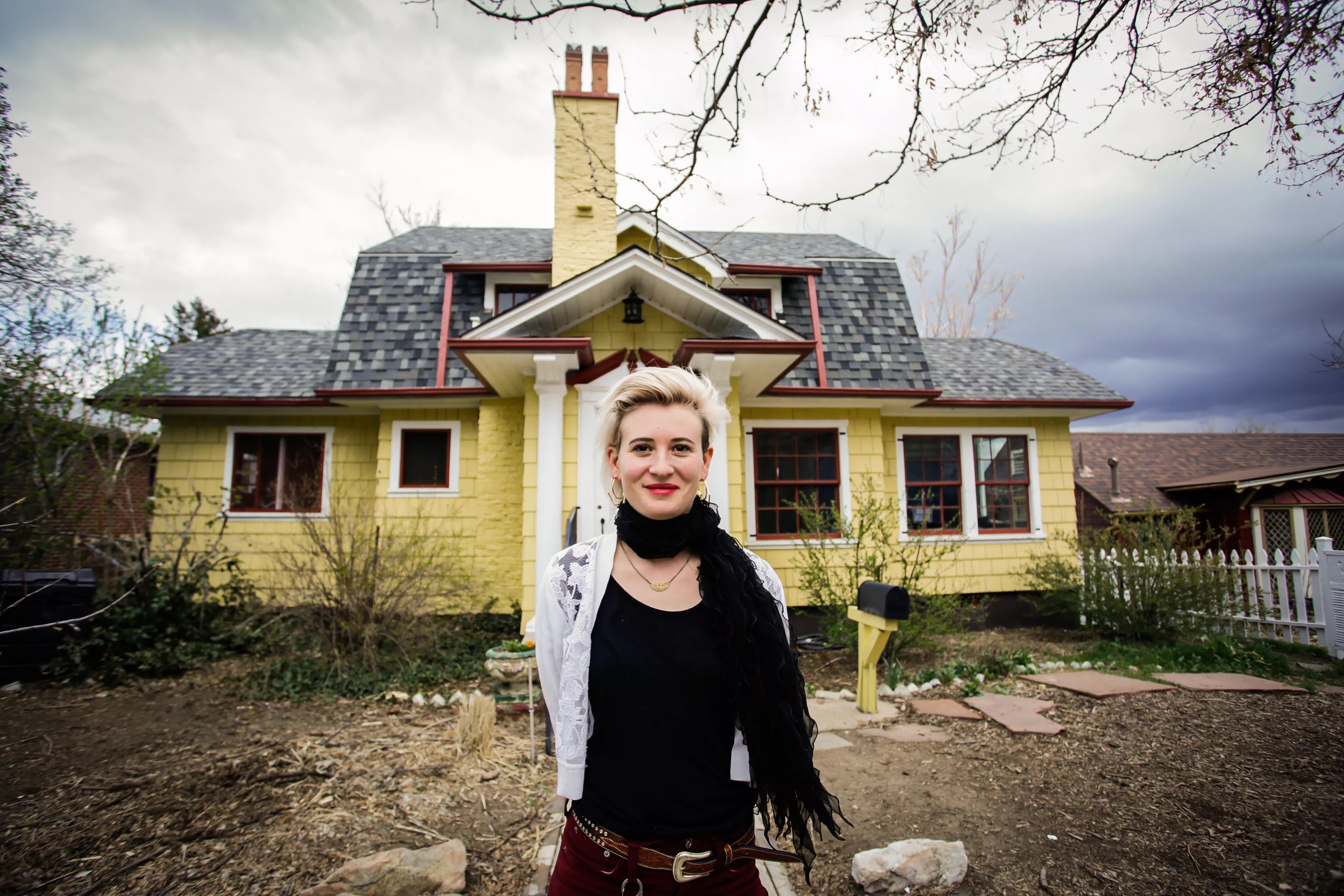
Art Heffron

Audio By Carbonatix
In her would-be buyer’s love letter for a 143-year-old house on King Street last April, Melanie Steinway described the building as “undoubtedly the most incredible house” in the Barnum neighborhood, “if not all of Denver.” The thirty-year-old artist and musician was trying to buy her first property, and the converted carriage house stood out from every other home she saw.
“Your house feeds the imagination,” she continued in her letter. “It encourages play. It vibrates with life and history. And what it speaks louder than anything is that it has stories to tell.”
Little did she know the extent of those stories.
The house had become part of Denver lore through the embellished stories of Robert Failing, a prior owner who called himself Bart Barnum. He gave tours of the property while claiming to be the great-great-grandson of P.T. Barnum, known for his “Greatest Show on Earth” traveling circus. But as a 2001 Westword article revealed, while Failing might have been quite a showman himself, he was no relation to P.T. Barnum.
Still, the show must go on, and Steinway and her housemates are using the space not just as a home, but as a DIY venue for intimate and curated house shows. They’re calling it the Barnum Better Animal Center in honor of Steinway’s dog, guinea pigs and a rabbit named Chicken.
Steinway had already been house-hunting for a number of months when she got an email from Redfin, a real estate brokerage, regarding the property on King Street. It was a two-story yellow house shaped like a barn, with a slate roof and red and white trim. Inside, every room was saturated with color and detail, and none of them attempted to coordinate with each other. It had a “seductively chaotic” charm, Steinway recalls.
The living room was covered with beige wallpaper, its fireplace surrounded by tiles depicting a waterfront town. There was a solarium with a stone floor, stained-glass ceiling and ornate wood trim. The kitchen had yellow patterned wallpaper – on the walls and the ceiling – as well as bright-yellow counters, bright-orange cabinets and a somewhat matching yellow-and-orange tiled floor. The master bedroom upstairs was blush pink.
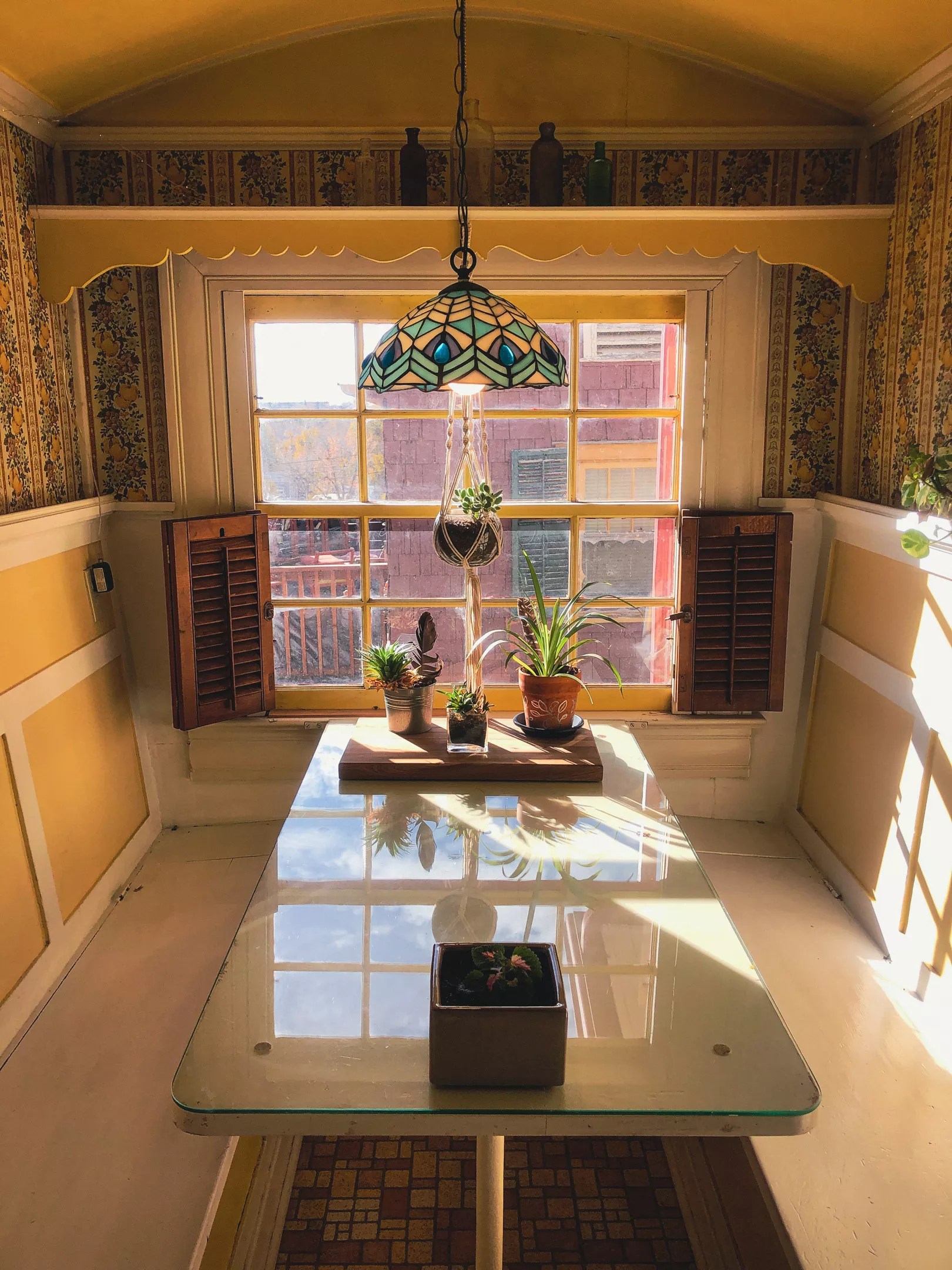
Each room of the Barnum House has its own personality.
Melanie Steinway
“I remember seeing this house pop up and being like, ‘Dad, you might want to drive down from Boulder to take a look at this one with me,'” Steinway recalls. “Because I was looking at the photos thinking, ‘What is going on here?'”
An illustrator and tattoo artist, Steinway specializes in depicting the natural world through a whimsical lens, and her illustrations create birds and wolves and whales out of detailed line work and simple geometric shapes. Sometimes she showcases mystical creatures, such as the forest spirit from Hayao Miyazaki’s Princess Mononoke, or mythological beings that are half human, half beast.
In addition to creating visual art, Steinway has performed in bands for much of the past eleven years. She fronted Tyto Alba, an indie-rock dream-pop outfit, and played lead guitar in Corsicana, an indie-rock band with shoegaze and electronic influences.
Buying a house was part of her parents’ vision of Steinway becoming a grownup. But in light of the pandemic and a number of life changes, she found the idea of establishing a place of her own resonating more and more.
Denver’s housing market was hot this past spring, though, and Steinway was discouraged by both the competition and the lack of personality she found in many buildings, describing them as “soulless, gray, overpriced remodels.” The King Street address played more to her sense of artistic adventure, and after touring the home, she, her father and realtor Scott Conroy discussed the potential of the property versus the amount of work it would need.
“My agent looked at me and was like, ‘Well, you’re definitely never gonna see a house like this again in Denver,'” Steinway says. “And I go, ‘Is this the first ten minutes of a horror movie?'”
But “I don’t think the house is haunted,” she adds. “I think if there’s a spirit in here, it’s very playful.”
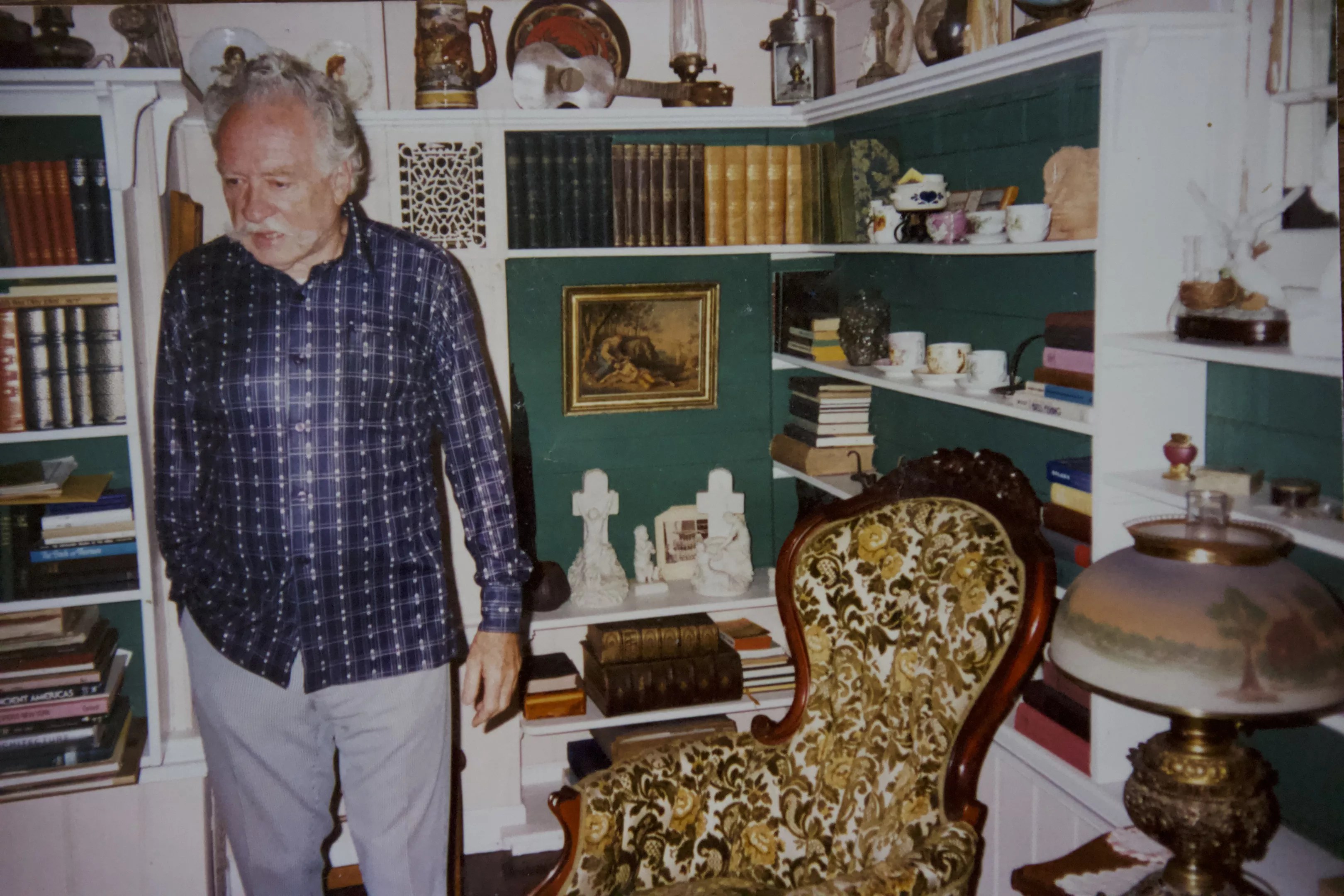
Robert Failing speaking in the library as Bart Barnum during a June 1995 tour.
courtesy of Melanie Steinway
The spirit she’s referring to is Robert Failing. Steinway calls him Barnum, noting that if her last name was Failing, she’d want a name change, too. And like the house’s former owner and P.T. Barnum himself, Steinway likes to mix fact with fiction, offering the truth of what she knows of the story alongside the possibilities of imagination.
For the record, P.T. Barnum never actually lived in Colorado. But in 1871, he bought 760 acres that included part of what is now the Barnum neighborhood. Known best for his Grand Traveling Menagerie, Caravan and Circus (today’s Ringling Bros. and Barnum & Bailey Circus), P.T. Barnum was also a speculator who made money buying land and building hotels across the United States. He even gave lectures on his techniques.
His Colorado purchase proved to be a flop, however, as the land was wet, muddy and cold, unsuited for building or housing his circus. He sold some of the property and called the rest Barnum Town, eventually gifting it to his daughter Helen Barnum Buchtel for $1. Barnum Town was annexed by Denver in 1896, and today the Barnum neighborhood extends from Sixth Avenue to Alameda Avenue and Federal Boulevard to Perry Street.
There are many myths connected to the area. Many residents believe that P.T. Barnum used the land to winter his circus. Some think that Zenobia Street was named after a Barnum elephant, and others tell how General Tom Thumb, a 25-inch-tall performer, participated in Elitch Gardens’ opening ceremony in 1890. The stories are so prevalent that in the 2000s, Denver Parks and Recreation built a circus-themed playground at Barnum Park.
Robert Failing used these stories as a vehicle for running his own Barnum-esque hoax. The house on King Street got its start in 1878 as a barn on the Helen Barnum Buchtel estate; Robert’s father, James Failing, bought the place in 1921 and converted it into a house before moving it to its current location in the 1950s. Failing spent most of his childhood living there.
While living in a house that was once on land owned by P.T. Barnum was as close as the connections came, Robert Failing’s claim to be his great-great-grandson took on a life of its own. The house was listed by the state as a tourist attraction, and “Bart” sometimes spoke about his “family connections” and the history of the Barnum area for bus tours of west Denver parks. He also gave free tours of the house, typically once a week and often to women’s groups, up until the early 2000s.
After his death, the house was sold in 2011, and the new owner turned it over quickly. Wendy Lu McGill, who bought it in 2012, sold the property to Steinway. She learned of Failing’s claims from a neighbor and by reading the Westword story.

The renovated solarium with the rabbit named Chicken and the stone floor that Robert Failing claimed to be from Mount Vesuvius.
Melanie Steinway
“He says that the floor of this room is lava from Mount Vesuvius,” Steinway says, pointing to the stone floor in the solarium and another nearby. “It’s all complete poppycock. I’m sure he would say that this floor is, like, exotic wood from Africa. It’s poplar. You’re not even really supposed to make floors out of it because it’s so soft.”
Still, Steinway admits that it’s fun to keep the rumors alive. She recently wrote a review on a wine app describing herself receiving a bottle of Petite Petit from a circus girl. “It paired perfectly with a bleary late autumn evening, and the elephant bones – upon uncorking the bottle – rattled in the backyard,” she recounts. “And the ghost of Barnum himself appeared behind me to comment, ‘Luscious notes of blackberry and dark fruit.'”
She plans to relabel the rooms much as Failing once labeled them for his tours. But for now, she’s putting all of her efforts into repainting, refinishing floors and rebuilding sections of the house to make it her own.
Andrew Bair, one of Steinway’s housemates, agrees that the “lore” is one of the charms of the “weird, quirky” house. Failing “made an entire life out of this lie,” he says. “It made sense to me. He was a con artist, and now Melanie’s an artist – fits the bill.”
Steinway and Bair met in Boulder in 2013 through mutual friends in the music scene. He played drums in Tyto Alba, as well as in Male Blonding from 2013 to 2018. He spent much of the past seven years working for different restaurants and bars around Denver, and currently bartends at the hi-dive. He also runs a pop-up vintage clothing business called Buckaroo Vintage, which mostly sells men’s casual wear from the ’70s, ’80s and ’90s.
He decided to move into the Barnum house in August when his prior lease expired; he’d already helped with some of the home renovations in the early spring and summer.
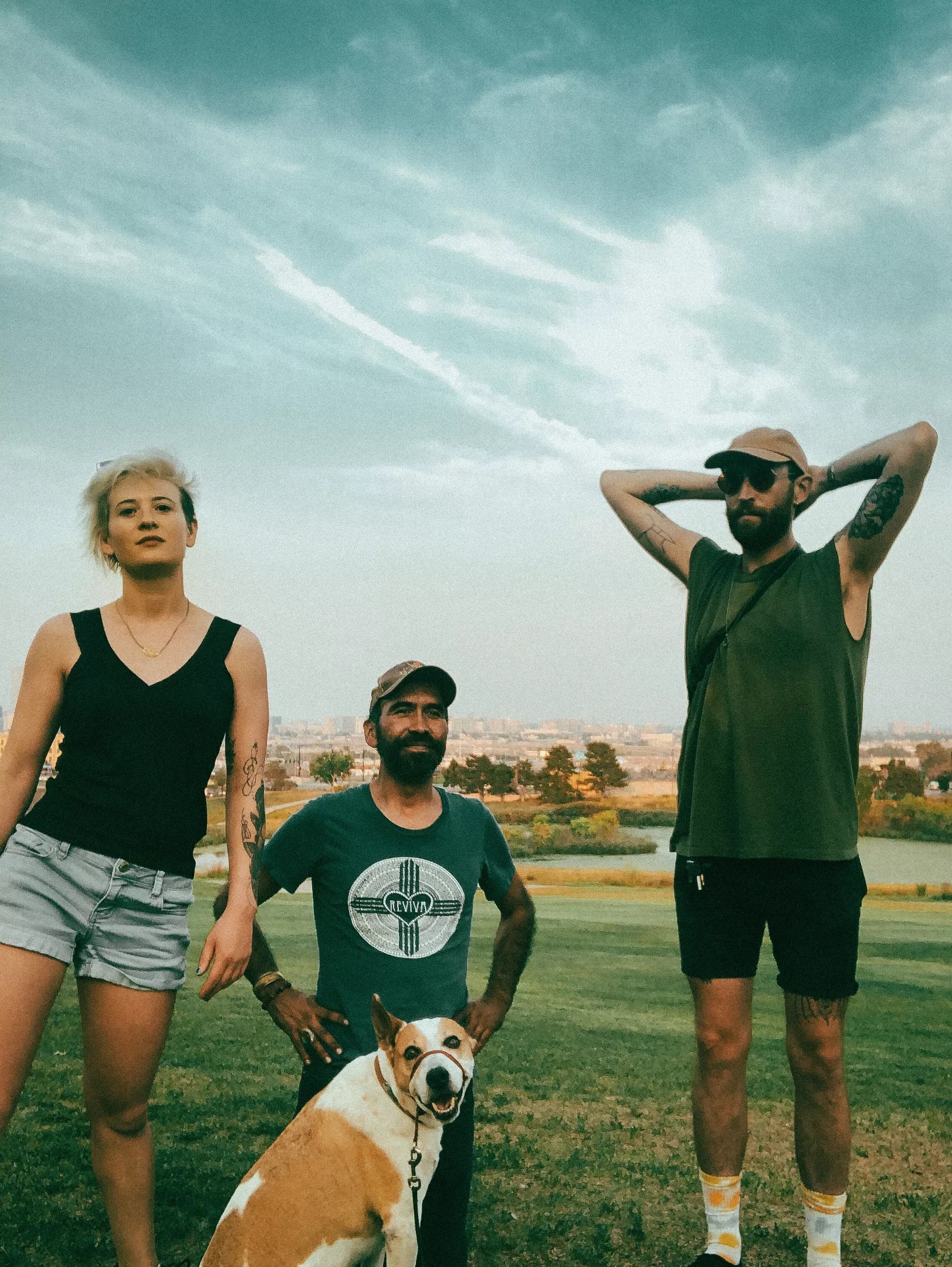
Melanie Steinway, Art Heffron and Andrew Bair along with Steinway’s dog, Django, at Barnum Park near their house.
Melanie Steinway
The third roommate is Art Heffron, a professional photographer whose subjects include real estate, portraiture and concert photography. He’s shot for the likes of John Prine, Gregory Alan Isakov and Brandi Carlile. Since 2008, he’s also been promoting Strings & Wood, a folk music-oriented concert series; he says he was inspired to move to King Street in part because of its potential as a site for shows.
Hosting house shows with Steinway and Bair is a way to “combine forces and bring all our little communities together,” he explains.
Steinway started hosting house shows as a college student at the Rhode Island School of Design. During her senior year, she and her two roommates shared a three-bedroom apartment in an old colonial house with an open layout that was well suited for intimate folk shows. She continued the tradition when she moved to West Washington Park in 2016. The house there had a large backyard and a hands-off landlord, and Steinway hired a fellow musician named Sawmill Joe to build a wooden stage in exchange for dinner and a bottle of mezcal. Her house show series gained a reputation as a fun place for intimate performances, and she and her housemates hosted two to three every summer.
When she was searching for a house to buy, space for concerts was an important factor.
“I want to share this space with the community,” Steinway says. “Art and Andrew and I, we’ve been in the music community for a really long time, and Andrew and I aren’t in a band anymore. This is sort of our way of continuing to be involved in that community, by hosting people and having them over.”
“We all have music in our blood, essentially,” Bair adds. “We want to be a part of Denver’s music scene, even if we’re not actively playing.”
The Barnum Better Animal Center has hosted three concerts since late summer. Two were outside and one was in the basement; all required that audience members be vaccinated.

Hosting shows is a way for the Barnum House residents to support the Denver music community.
Melanie Steinway
Steinway hosted the first show alongside longtime Mountain to Sound promoters Greg and Garrett Hilpipre and Jamie DiProjetto, as well as Strings & Wood. The event, called The Shindig, has been an unofficial UMS party since 2013. This year it showcased Joe Sampson, Jen Korte and the Loss, and Street Cats Making Love. The event had sponsors and a doorman, and Steinway invested in quality sound equipment and lighting. She even spent weeks clearing the yard of old stumps, weeds and large rocks.
The promotional poster, illustrated by Steinway, depicted the Barnum house surrounded by circus animals.
Each show ends by 11 p.m., at the request of the neighbors: two families, one on either side of the street. Across the street is a nonprofit; behind the house is a church. “We’ve been really fortunate, because it takes a special house to even be able to do house concerts,” Heffron explains. “It really is dependent upon your neighbors and if they’re down with that type of thing.”
The Barnum Better Animal Center doesn’t host rowdy house shows, and guests are expected to be courteous and respectful. “It’s not like some trashy punk house. The space is well curated,” Steinway says. “As you get older, everything just becomes a little bit more deliberate. You realize that your time and your energy and resources are valuable.”
Heffron agrees. He hosted his first show at the Barnum house in October, with The River Arkansas and Brianna Straut each playing their own rendition of heartfelt roots and Americana music, creating the kind of welcoming atmosphere he’s promoted over the past thirteen years. But Heffron is focusing his energy in other ways these days.
When he started Strings & Wood, he generally hosted nine to twelve shows a year. And though he tried to cut back on the number of shows he curated, he still promoted nine shows in 2019. During the first months of the pandemic, though, he realized he needed to focus on his photography for income and host shows occasionally, just for love.
“I’ve wrestled with my relationship with the music industry, but it’s something that I obviously can’t get away from,” Heffron says. “I always get sucked back in because it’s such magic and such beauty.”
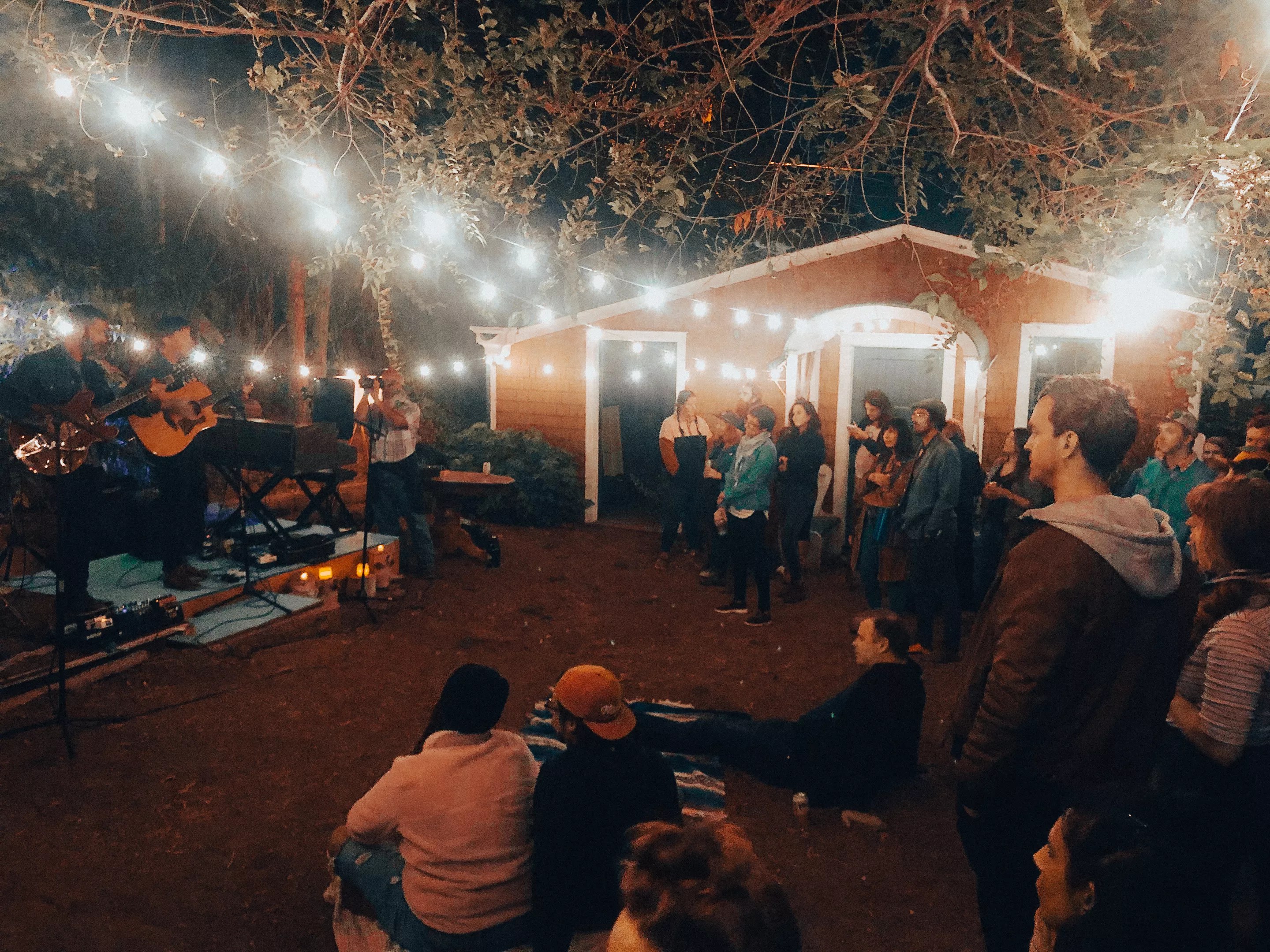
The River Arkansas played at the Barnum Better Animal Center in early October.
Melanie Steinway
The Barnum residents prioritize paying bands over making money themselves. After the Shindig, for example, they were able to pay each band $200. “That does make a difference,” Steinway says. “After being in a band for so long, I get how much work it is.” They have an extra bed in the basement in case a musician needs a place to spend the night.
Bair had previously booked shows for Male Blonding and set up a handful of performances at Syntax Physic Opera before it became the Roxy on Broadway. This is the first time he’s lived in a place where he’s put on shows.
The “ethos” of the Barnum Better Animal Center is “wanting a sense of community and giving people the space to be creative and us to be creative by putting these things on,” he explains. Even though having people in their personal space “can be worrisome at points,” all the “attention to detail” mitigates most problems.
“I like to try to curate our vibe for each show,” Bair adds, but he’s also brainstorming how to take the helm for occasional evenings.
“We all have that love of hosting and that love of having people in creating that space,” Heffron says. “It takes special people to live together to even be open to that type of lifestyle.”
And to welcome the stories about Failing.
“You’ve got to feel that whoever was here in the past, there’s some sort of thread of joy and community still happening,” Heffron notes. “Sometimes I’ll pause on those nights and just look out, look around the room and be like, ‘This is lovely.’ And this house probably really appreciates that there’s still some sort of atmosphere happening.”
During one of their shows, Steinway learned that a friend’s mother knew the house’s address from parties in the 1980s. “I’ll bet Bart Barnum threw a bunch of parties,” she says. “This place begs for events.”
Learn more about Melanie Steinway, Buckaroo Bair and Strings & Wood on their social media pages, where they will also announce house shows.